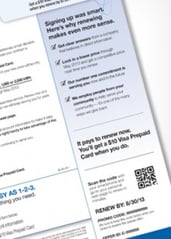

J&C Blog
Find all the latest marketing trends on the J&C Blog.

Find all the latest marketing trends on the J&C Blog.
Architecting a successful direct mail campaign is as much science as art. When companies utilize direct mail and it doesn’t perform, they often blame the channel as a whole, rather than dissecting that individual direct mail initiative and looking for improvements.
There are a number of common mistakes that companies make in developing direct mail. This article outlines some of those mistakes and how to leverage direct marketing best practices to make adjustments that can lead to successful direct mail campaigns.

1. Assuming your audience is just like you
You probably spend most of your day feeling time-compressed, catching up with emails, phone calls and running to meetings. Often when reading written correspondence, you probably wish people could get to the point quicker.
One of the most common pieces of feedback I hear from marketers is to shorten up the direct mail letter. The reality, however, is that one of the core direct marketing best practices is to make sure you provide all of the necessary information to get the target to “yes.” Don’t assume everyone is alike, and that no one will read an entire direct mail letter, or that readers only review the brochure. In direct marketing studies, we’ve found that not everyone consumes information in exactly the same way. This is why a direct mail best practice is to include a letter and brochure in each package, presenting redundant information in different formats.
 Additionally, the direct mail letter should present the information in two different ways. The content should include full content in paragraph form in the body, with key bullets called out in either the right-hand column or within the letter itself. This allows the audience to read the content however they prefer, i.e., in-depth or by scanning.
Additionally, the direct mail letter should present the information in two different ways. The content should include full content in paragraph form in the body, with key bullets called out in either the right-hand column or within the letter itself. This allows the audience to read the content however they prefer, i.e., in-depth or by scanning.
Multichannel communications have influenced the amount of information that is incorporated into a direct mail package. Some direct mail packages have an objective of only lead generation. In the case where the goal is lead generation, less can be more as the goal is to get a user to a landing page, versus utilizing direct mail as a sign-up mechanism. In this case, the objective dictates the amount of information.
It’s critical, however, to always put yourself in the recipient’s shoes and consider what information they need to make a decision. And follow direct marketing best practices, which call for redundancy across components within a direct mail package, e.g., the direct mail letter and brochure.
2. Worrying about channel attribution over multichannel effectiveness
Marketers are under increasing pressure to account for their marketing expenditures. Unfortunately, few channels work alone anymore. Multichannel interdependency is a reality in marketing today. While direct mail is growing annually, and overall response rates remain steady, direct mail doesn’t perform on its own very often. 2 out of 3 people who receive direct mail make a purchase or also engage in a different marketing channel.1 Worrying about channel attribution and accounting for the response derived from direct mail, over the total campaign, is probably a mistake.
3. Mailing to your entire universe, or even a high percentage of all prospects
Many marketers still aren’t leveraging predictive modeling and other targeting techniques to ensure effective spending of marketing dollars. This is one of the key reasons that direct marketing programs fail, and don’t deliver on expected results. Targeting is the number-one driver in delivering a successful direct mail program.
Predictive marketing is a critical technique to delivering an effective cost per acquisition. Predictive modeling allows you to target those most likely to respond, thus increasing efficiency and eliminating waste. This is a fundamental best practice of direct mail and one of the key aspects that many marketers still aren’t taking advantage of today. Rather than mailing to your entire universe, leverage predictive modeling to focus your marketing dollars to reach your target. It will reduce your investment and waste, while increasing your response rate.
4. Direct mail is treated as a pull or awareness medium presenting multiple choices
One of the golden rules in direct marketing is providing people with a choice that requires a yes/no answer. Giving people multiple choices in direct mail is a big no-no. This direct marketing best practice is predicated on the human behavior that it’s easier for people to say yes I want this, or no I don’t, over weighing the trade-offs of a number of options.
Consider this scenario. You go into an ice cream or yogurt shop and the person behind the counter says, “Would you like chocolate today?” You can immediately answer with a yes or no. Pretty straightforward question, right? You are then posed with the question, “Do you want chocolate, chocolate chip, peanut butter, vanilla or strawberry?” Since you went into the shop intending to make a choice, you eventually make one. But you had to stop and think about it. In direct marketing, you don’t want to put people to that type of test. There are certain communication channels appropriate for that level of shopping. Specifically, search, content marketing and social media are pull channels, in which the user is in a shopping mind-set. Disruptive media such as direct mail require a streamlined, simple approach, typically in which the user can say yes, I want to respond, or no, I don’t.
5. Believing everyone wants to respond via a web page
One of the key misconceptions I hear marketers discussing is that the majority of their responders are coming in through a landing page; therefore, they don’t need to provide a phone number or printed response device. The reality is that today users want and expect options. They are accustomed to having alternatives on ways to respond.
One key trend is ensuring landing pages are mobile-friendly. This is becoming a user expectation, and ignoring this trend is likely to suppress response.
 Furthermore, users are accustomed to having things their way. Not all prospects and customers are alike. And just as important, not all prospects are just like you or me. In general, we still find that about 20 to 25% of target customers will respond using the printed response device, i.e., they will mail back an enrollment form. This is because the printed response device in direct mail serves as both a physical and subliminal reminder to respond.
Furthermore, users are accustomed to having things their way. Not all prospects and customers are alike. And just as important, not all prospects are just like you or me. In general, we still find that about 20 to 25% of target customers will respond using the printed response device, i.e., they will mail back an enrollment form. This is because the printed response device in direct mail serves as both a physical and subliminal reminder to respond.
While generally giving the target too many choices in mail suppresses response (e.g., different prices or plans), giving a choice in how to respond is a key best practice. A direct mail best practice is to provide: a response mechanism, such as a mail-back enrollment form; a phone number; and a web link/URL.
6. Over crediting recipients’ ability to take action
By nature, many people are procrastinators. Direct marketing best practices have always preyed on this human behavior and insight. A successful direct mail campaign is generally built off direct mail letters that underscore the urgency in making response easy for the user. A standard direct mail best practice is to provide a call-to-action multiple times within the direct mail letter, and to be extremely clear on the desired action. A rule of thumb is a minimum of three times within the letter alone.
7. Not doing enough to break through the clutter
The average person gets 9,000 emails a year, and that number is conservative for many of us.2 Digital media has increased the number of messages that inundate prospects and customers, further underscoring the need for relevancy and personalization. Relevancy is the only hope marketers have to get users’ attention and their response.
This year, J&C conducted several communication preference research studies. And we have universally found that customers prefer and have come to expect personalized communications. Furthermore, successful direct mail campaign tests show that personalized information, including personalized URLs (PURLs), empower and reinforce your direct mail communications.
A direct mail best practice is to leverage segmentation and targeting to improve relevancy. Generic direct mail packages without personalization have been proven to be not as effective and produce inferior results compared with packages with meaningful and accurate personalization.
Ensuring successful direct mail campaigns requires discipline and adherence to direct marketing best practices.
1. ExactTarget 2012 Channel Preference Study
2. 2013 Jacobs & Clevenger Retail Communication Preferences Study
Topics: Direct Marketing
303 E Wacker Drive, Suite 2030
Chicago, IL 60601
Phone: 312-894-3000
Fax: 312-894-3005